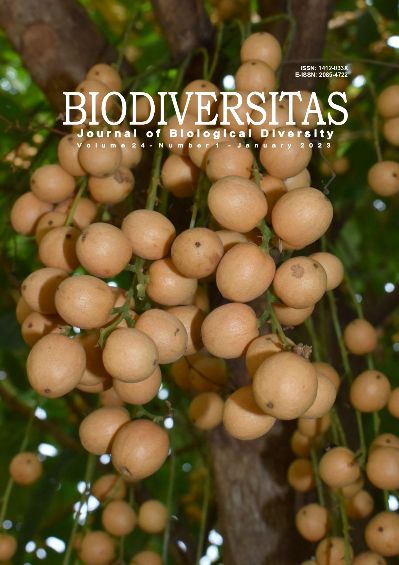Animals ethnozoology as traditional medicine in the Dayak Tamambaloh Tribe, Labian Ira'ang Village, Kapuas Hulu District, Indonesia
##plugins.themes.bootstrap3.article.main##
Abstract
Abstract. Supiandi MI, Syafruddin D, Gandasari A, Mahanal S, Zubaidah S. 2023. Animals ethnozoology as traditional medicine in the Dayak Tamambaloh Tribe, Labian Ira'ang Village, Kapuas Hulu District, Indonesia. Biodiversitas 24: 26-33. The Dayak Tamambaloh community in Labian Ira'ang Village, Kapuas Hulu District, Indonesia, is a community that has traditional knowledge of the use of fauna. However, at this time this knowledge has been reduced or relegated by the times and the use of animals and has never had a written document. This study aimed to obtain the types of animals used by the Dayak Tamambaloh people for treatment. The method used was a survey. Data was collected through literature studies, semi-structured interviews, and field observations. Data on using animals as traditional medicine was obtained from main informants, key informants, and recommendation informants. Data analysis was descriptive and qualitative, including data collection, data reduction, data presentation, and conclusions. The results obtained 13 types of animals in 13 families that are used as traditional medicine by the Tamambaloh Dayak people. The types of animals used in traditional medicine were wanyi (Apis cerana), asu (Canis lupus familiaris), kandalak (Channa striata), panang (Clarias sp.), bunsok (Gekko gecko), dingkawat (Hipposideros larvatus), lati loman (Lumbricus terrestris), tangkiling (Manis javanica), takiung (Sulcospira testudinaria), manuk (Gallus gallus domesticus), ular sawa (Malayopython reticulatus), lundung (Monopterus albus), and beruang (Ursus thibetanus). Animal families used as traditional medicine were Apidae (1 spesies), Canidae (1 spesies), Channidae (1 spesies), Clariidae (1 spesies), Gekkonidae (1 spesies), Hipposideridae (1 spesies), Lumbricidae (1 spesies), Manidae (1 spesies), Pachychilidae (1 spesies), Phasianidae (1 spesies), Pythonidae (1 spesies), Synbranchidae (1 spesies), and Ursidae (1 spesies). The Dayak Tamambaloh people use meat, bile, scales, shells, egg whites, wax, and all parts of animals for traditional medicine.
##plugins.themes.bootstrap3.article.details##
Most read articles by the same author(s)
- MARKUS IYUS SUPIANDI, SUSRIYATI MAHANAL, SITI ZUBAIDAH, HENDRIKUS JULUNG, BENEDIKTUS EGE, Ethnobotany of traditional medicinal plants used by Dayak Desa Community in Sintang, West Kalimantan, Indonesia , Biodiversitas Journal of Biological Diversity: Vol. 20 No. 5 (2019)
- MARKUS IYUS , BENEDIKTUS EGE, HENDRIKUS JULUNG, SITI ZUBAIDAH, SUSRIYATI MAHANAL, Ethnobotany of traditional medicine in Dayak Jangkang Tribe, Sanggau District, West Kalimantan, Indonesia , Biodiversitas Journal of Biological Diversity: Vol. 22 No. 12 (2021)
- SITI ZUBAIDAH, SUHARTINI AZIS, SUSRIYATI MAHANAL, JATI BATORO, SUTIMAN B. SUMITRO, Local knowledge of traditional medicinal plants use and education system on their young of Ammatoa Kajang tribe in South Sulawesi, Indonesia , Biodiversitas Journal of Biological Diversity: Vol. 21 No. 9 (2020)
- WISANTI, DURAN COREBIMA ALOYSIUS, SITI ZUBAIDAH, SRI RAHAYU LESTARI, Variation in morphological characters of Marsilea crenata living in floating aquatic, emergent aquatic, and terrestrial habitats , Biodiversitas Journal of Biological Diversity: Vol. 22 No. 7 (2021)
- MARKUS IYUS SUPIANDI, HENDRIKUS JULUNG, YUDITA SUSANTI, SITI ZUBAIDAH, SUSRIYATI MAHANAL, Potential of traditional medicinal plants in the Dayak Tamambaloh Tribe, West Kalimantan, Indonesia , Biodiversitas Journal of Biological Diversity: Vol. 24 No. 6 (2023)
- MARIA MONICHA FAOT, SITI ZUBAIDAH, HERU KUSWANTORO, Genetic correlation and path analysis of agronomical traits of soybean (Glycine max) lines infected by CpMMV , Biodiversitas Journal of Biological Diversity: Vol. 20 No. 6 (2019)
- PANJI HANDOKO BADIARAJA, SITI ZUBAIDAH, HERU KUSWANTORO, Maternal effect of agronomic and morphological characters on cluster structure of F3 soybean lines , Biodiversitas Journal of Biological Diversity: Vol. 22 No. 2 (2021)
- YUDITA SUSANTI, MARKUS IYUS SUPIANDI, HENDRIKUS JULUNG, SITI ZUBAIDAH, SUSRIYATI MAHANAL, Lexicon of medicinal plants in traditional medicine in the Dayak Tamambaloh Tribe (West Kalimantan, Indonesia): An ethnolinguistic approach , Biodiversitas Journal of Biological Diversity: Vol. 24 No. 1 (2023)

